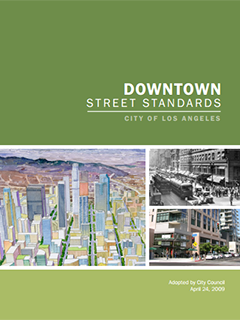Downtown Street Standards
Street dedications and roadway widenings have been contentious issues for developers in Downtown Los Angeles, especially as they relate to the desire for wider sidewalks and the impact to development in the historical core, where significant landmarks block the implementation of currently set citywide standards for wider roadways. The Downtown Street Standards updated the Central City Community Plan street designations based on a more comprehensive street hierarchy that balances traffic flow with other equally important functions of the street, including: pedestrian needs, public transit routes and stops, bicycle routes, historic districts with fixed building street walls, the public face and transitional "front yard" of businesses, pedestrian environments and linear open space considerations. They were adopted by the City Council on April 24th, 2009 and have been incorporated into the Bureau of Engineering's web based mapping application NavigateLA.
The new Downtown Street Standards establish definitive future curb lines and property lines for all Downtown streets, and, in some locations, additional required average sidewalk easements. In combination with the Downtown Design Guide, the Downtown Street Standards will provide certainty for developers and their architects as to the building street wall location and required roadway improvements. It will also provide certainty for building, business and homeowners that the character of their street on which their investments are located will not be diminished by unanticipated future sidewalk narrowing.
The Downtown Street Standards consist of a series of street cross sections which are specific to each street or street segment, including one-way pair standards, rather than a single cross section for all Major Highways Class II, a single cross section for all Secondary Highways, and a single cross section for all Collectors as currently exists. This work effort is consistent with the current practice among transportation planners to design for "complete streets" that are "context sensitive" and promote sustainable development for a revitalized Downtown.
